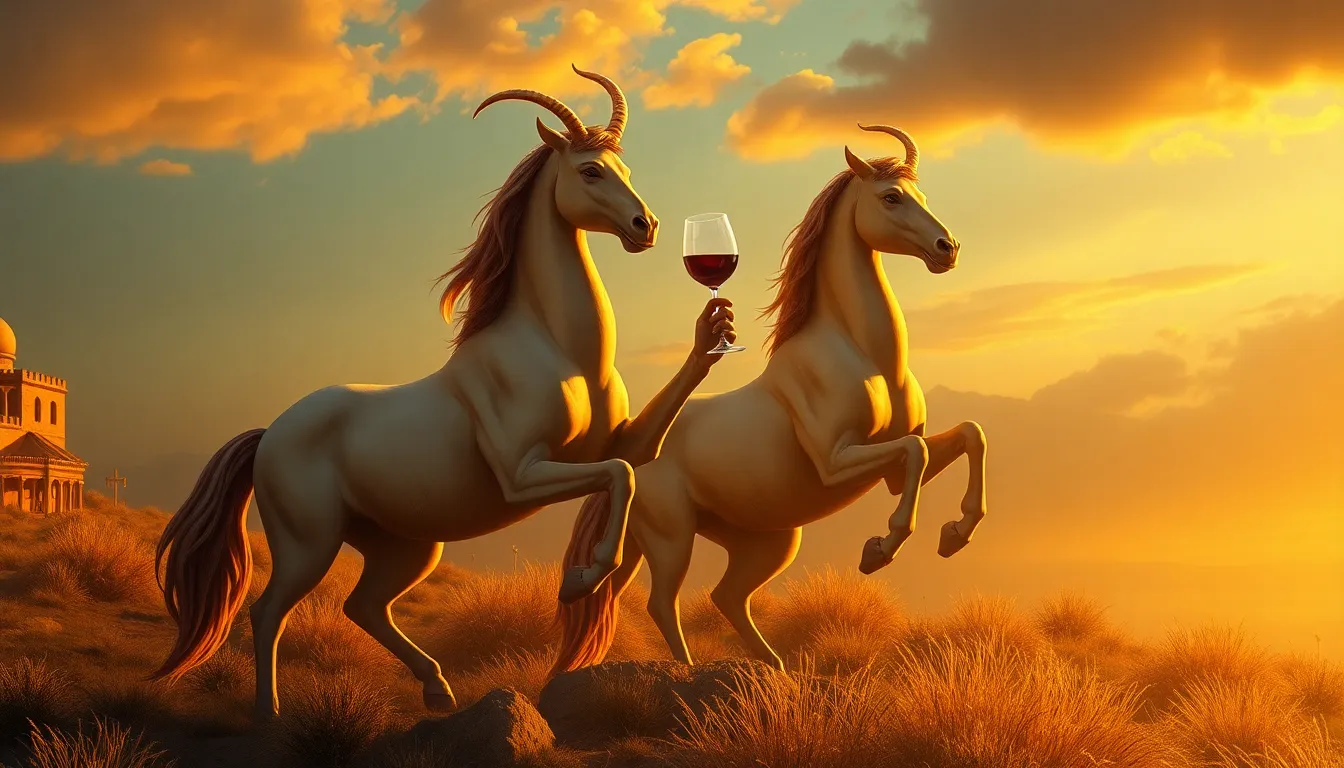Centaurs and Their Symbolic Connection to Wine and Celebration
I. Introduction
Centaurs hold a unique place in Greek mythology, captivating the imagination with their dual nature as both human and horse. These creatures symbolize the tension between civilization and savagery, embodying the complexities of human experience. In ancient cultures, wine was not just a beverage but a vital element of social life, representing festivity and communal gathering. This article explores the symbolic connections between centaurs, wine, and celebration, revealing how these themes intertwine in mythology and culture.
II. The Mythological Background of Centaurs
Centaurs are mythical beings, typically depicted with the upper body of a human and the lower body of a horse. They are believed to originate from the union of Ixion, a king of the Lapiths, and a cloud created by Hera, which took the form of the goddess. This origin reflects their duality: they embody both the rationality of humans and the instinctual nature of horses.
Notable centaurs include:
- Chiron: Renowned for his wisdom and healing abilities, Chiron was an educator to many Greek heroes.
- Eurystheus: Known for his conflicts with Heracles, Eurystheus represents the more savage and chaotic aspects of centaur nature.
- Pholus: A friendly centaur who hosted Heracles, Pholus’s story intertwines with themes of hospitality and the consequences of excess.
Centaurs epitomize the constant struggle between civilization and savagery. While some centaurs, like Chiron, embody noble qualities, others represent the chaotic and wild nature of humanity, especially when influenced by wine and revelry.
III. The Role of Wine in Ancient Cultures
Wine has played a significant role in Greek and Roman societies, serving not just as a drink but as a symbol of life, celebration, and divinity. The cultivation of vineyards and the production of wine were vital to both economies and cultural practices.
Key aspects of wine’s importance include:
- Historical Significance: Wine was closely associated with fertility, prosperity, and the gods, particularly Dionysus, the god of wine and ecstasy.
- Symbol of Festivity: Wine was central to social gatherings, banquets, and celebrations, fostering a sense of community.
- Ritualistic Use: In various religious ceremonies, wine served as an offering to the gods, symbolizing the connection between the divine and human realms.
IV. Centaurs as Symbols of Wine and Festivity
In art and literature, centaurs are frequently depicted in scenes of wine consumption and celebration. Their presence often signifies the joys and chaos associated with revelry, particularly in the context of Dionysian festivities.
The connection between centaurs and Dionysian celebrations is evident in:
- Literature: Works like Euripides’ “The Bacchae” illustrate the interplay between human instincts and divine ecstasy, often featuring centaurs in the background.
- Art: Classical sculptures and paintings frequently portray centaurs indulging in wine, highlighting their association with both joy and chaos.
Centaurs embody the essence of revelry, representing both the joy of celebration and the potential for chaos that accompanies excess.
V. The Dual Nature of Celebration: Joy and Excess
Celebration is often marked by joy, community, and shared experiences. Centaur symbolism reflects these positive aspects through their association with festive gatherings. However, the stories surrounding centaurs also reveal the darker side of revelry.
Key themes include:
- Positive Aspects: Celebrations foster a sense of belonging and joy, often enhanced by the presence of wine and communal activities.
- Darker Side: Excessive drinking can lead to chaos, loss of control, and destructive behavior, as seen in the stories of unruly centaurs.
- Parallels with Human Behavior: The centaurs’ wildness mirrors the potential for human excess during celebrations, reminding us of the fine line between joy and chaos.
VI. Contemporary Interpretations of Centaurs and Wine
Centaur mythology continues to influence modern culture, often serving as a metaphor for the complexities of human nature. The resurgence of interest in wine and celebration in contemporary society has led to a reevaluation of centaur symbolism.
Contemporary interpretations include:
- Influence in Art: Modern artists often draw on centaur imagery to explore themes of duality and the human experience.
- Wine Culture: The appreciation for wine has grown, with celebrations often reflecting the balance of enjoyment and moderation.
- Symbolic Reinterpretations: Centaurs are increasingly seen as symbols of the joyful yet chaotic nature of life, resonating with modern festivities.
VII. The Psychological and Cultural Significance
The enduring legacy of centaurs extends beyond mythology, playing a crucial role in understanding human nature and desires. Their dual nature serves as a lens through which we can examine our own complexities.
Key aspects of this significance include:
- Understanding Human Nature: Centaurs represent the struggle between rationality and instinct, a theme prevalent in human psychology.
- Wine as a Catalyst: Wine fosters social bonding, serving as a medium for cultural expression and celebration.
- Enduring Legacy: Centaurs continue to resonate in contemporary celebrations, reminding us of the balance between joy and chaos.
VIII. Conclusion
In conclusion, the symbolic connections between centaurs, wine, and celebration are rich and multifaceted. Centaurs embody the duality of human nature, reflecting the joy and chaos inherent in revelry. Their presence in ancient myths and contemporary culture highlights the importance of mythological figures in shaping our understanding of social practices and human desires. As we celebrate today, the relevance of centaur symbolism reminds us to embrace the balance between enjoyment and moderation, ensuring that our festivities bring joy without succumbing to chaos.




